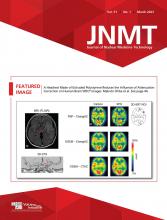Abstract
Dual-tracer PET/CT (18F-FDG and 68Ga-DOTATATE) has become established practice in the management of metastatic neuroendocrine neoplasms (NENs) and has demonstrated the advantages to patient management of deciphering the molecular PET characteristics of the tumor. Judicious elucidation of the findings is important, especially in scenarios of discordance with reported histopathology, potentially leading to an unsuspected diagnosis such as second primary malignancies. Such a diagnosis established early in the disease course, and mostly at an asymptomatic stage, provides lead time for timely, appropriate management. This concept was elaborated in a case of incidentally detected 18F-FDG–avid metachronous lung adenocarcinoma in a patient with metastatic, well-differentiated gastric NEN, wherein dual-tracer PET/CT showed 18F-FDG–avid but not 68Ga-DOTATATE–avid lung opacity.
Neuroendocrine neoplasms (NENs) comprise a heterogeneous group of tumors originating from neuroendocrine cells at different sites and organs. Few reports have highlighted the link between NENs and associated second primary malignancies (1,2), with the prevalence of second primary malignancy ranging from 4% to 25% in different cohorts and an observed preponderance of gastrointestinal, genitourinary, and breast malignancies, primarily in settings of gastrointestinal and pancreatic NENs. The utility of dual-tracer PET/CT (18F-FDG and 68Ga-DOTATATE) in NENs is now evident (3), providing multiple added merits such as an understanding of tumor biology and intra- and intertumoral heterogeneity, help with treatment decision making, and (rarely) detection of multifocal primary NENs and second primary malignancies. Discordant 18F-FDG–positive/SSTR-negative lesions, especially in low-grade NENs, might correspond to a second primary or NEN tumor heterogeneity. We present a case of metastatic gastric NEN in which a metachronous primary lung malignancy was diagnosed primarily through suspicion when discordance on dual-tracer PET/CT was seen in an asymptomatic patient.
CASE STUDY
A 60-y-old-man who had a giant excavating ulcer with an elevated margin at the greater curvature of the stomach was diagnosed on endoscopic biopsy to have metastatic grade II well-differentiated gastric NEN (Ki-67, 5%). He had received 2 cycles of 177Lu-DOTATATE peptide-receptor radionuclide therapy (cumulative dose: 13.87 GBq) in view of progressive disease, and uptake with a Krenning score of 4 was seen in multiple hypodense liver lesions on 68Ga-DOTATATE PET/CT (Fig. 1).
Baseline 68Ga-DOTATATE PET/CT (upper left: maximum-intensity projection image; upper right: fused coronal; lower left: transaxial CT only; and lower right: fused transaxial) showing multiple SSTR-expressing hepatic metastases (liver segment V lesion).
Recent follow-up PET/CT with 68Ga-DOTATATE showed somatostatin receptor (SSTR)–expressing stable hepatic disease, but there was a minimally SSTR-expressing centimeter-sized ill-defined opacity at the upper lobe of the right lung, initially suspected of being metastatic disease. The lesion was 18F-FDG–avid (Fig. 2) (SUVmax, 9.6). Considering that this new lesion was not consistent with other hepatic metastatic lesions, a CT-guided biopsy was considered. Subsequently, the patient defaulted for more than 6 months and missed his appointments because of the coronavirus disease 2019 lockdown.
18F-FDG PET/CT after 2 cycles of peptide-receptor radionuclide therapy (upper left: maximum-intensity projection image; upper right: fused coronal; lower left: transaxial CT; and lower right: fused transaxial) showing 18F-FDG–concentrating (SUVmax, 9.6) ill-defined opacity in upper lobe of right lung.
At the next visit, he was reevaluated with dual-tracer PET/CT (Figs. 3 and 4), which showed SSTR-expressing multiple (at least 4) hypodense lesions in both lobes of the liver and a soft-tissue mass at the splenic hilum. In the upper lobe of the right lung, an 18F-FDG–avid lesion of soft-tissue density and with irregular margins was noted, along with a similar new, smaller lesion in the apical segment of the same lobe. Although the hypodense liver lesions and the soft-tissue lesion at the splenic hilum were weakly 18F-FDG–concentrating, both the SSTR-avid hepatic lesions and the 18F-FDG–avid lung lesions showed an increase in size and tracer uptake suggestive of disease progression (Fig. 3). Considering the discordance in the lung lesions (18F-FDG–avid but not SSTR-expressing), the possibility of a metachronous primary lung malignancy arose. The larger lung lesion was targeted with CT-guided biopsy and, on histopathology, was found to harbor primary pulmonary adenocarcinoma. On immunohistochemistry, the tumor cells were positive for thyroid transcription factor-1 but negative for synaptophysin. The patient underwent a further peptide-receptor radionuclide therapy cycle, with a referral to a thoracic oncologist, who performed mutational analysis. The patient’s disease course has since remained symptomless for both malignancies.
Follow-up dual-tracer PET/CT maximum-intensity projections obtained 6 mo apart (right panel later than left panel) and showing disease progression in terms of increase in size and number of SSTR-expressing hepatic lesions on 68Ga-DOTATATE PET/CT and increase in size and number of 18F-FDG–avid lung lesions on 18F-FDG PET/CT.
Follow-up dual-tracer transaxial PET/CT images showing 18F-FDG–avid (SUVmax, 10.9), non–SSTR-expressing (SUVmax, 4.7) lung lesions in right upper lobe (A and B); non–18F-FDG-concentrating (SUVmax, 2.8), highly SSTR-expressing (SUVmax, 29.4) hypodense segment V lesion in liver and nodal mass at splenic hilum (C); and similar non–18F-FDG-concentrating (SUVmax, 2.4), highly SSTR-expressing hypodense segment VI lesion in liver (SUVmax, 26.5) (D).
DISCUSSION
The present report emphasizes the importance of performing dual-tracer PET/CT examinations and analyzing them adequately to decode the disease pathology. There is one report that discordance on dual-tracer PET/CT had utility in the diagnosis of triple-negative breast carcinoma in a patient with NEN (4). Dual-tracer PET/CT has also enabled a diagnosis of primary lung NEN in the scenario of metastasis with unknown primary (5). This molecular PET imaging technique enables us to understand the biology of tumor lesions noninvasively and can provide added benefits as demonstrated in this case.
In the presented case, dual-tracer PET/CT findings raised suspicion regarding the lung lesion noted early in the disease course. Such findings have potential to provide enough lead time to make treatment with curative intent feasible.
CONCLUSION
This case underscored the value of correlation of discordant findings on dual-tracer PET/CT in NEN patients, including use of biopsy when indicated. Attending physicians should be familiar with NEN variants and differentials when interpreting such studies.
DISCLOSURE
No potential conflict of interest relevant to this article was reported.
REFERENCES
- Received for publication October 21, 2021.
- Revision received March 2, 2022.











